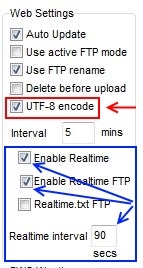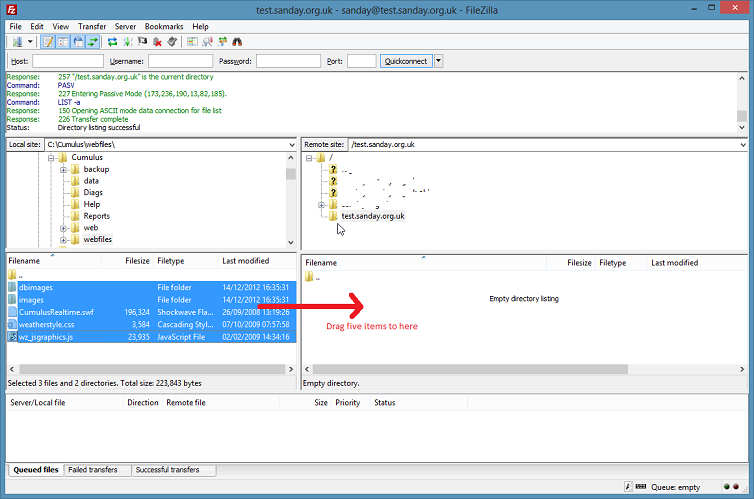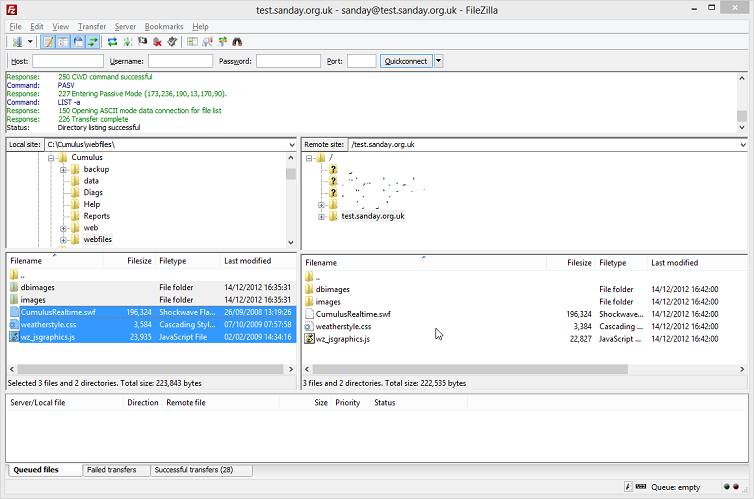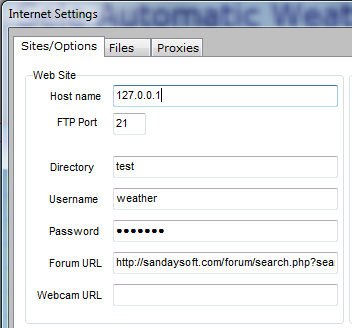Simple Website setup: Difference between revisions
mNo edit summary |
|||
| Line 46: | Line 46: | ||
#This is a one time only exercise but is essential to the operation of your Cumulus website. |
#This is a one time only exercise but is essential to the operation of your Cumulus website. |
||
#Configure your [[FTP tool]] to connect to your web server. |
#Configure your [[FTP tools|FTP tool]] to connect to your web server. |
||
#Once done, make your connection and change to the correct directory/folder on your site, as advised by your provider. |
#Once done, make your connection and change to the correct directory/folder on your site, as advised by your provider. |
||
#You may wish to create a sub-folder to store your weather site, but for this purpose we will assume not. |
#You may wish to create a sub-folder to store your weather site, but for this purpose we will assume not. |
||
Latest revision as of 21:15, 16 April 2021
The 'Simple Website' setup is by far the easiest and quickest way to get your Cumulus 1.9.4 data online. It uses the standard Cumulus 1.9.4 web templates and the process is well documented in the Help files for Cumulus 1 under 'Setting Up your Website'.
However this article (which is ![]() only for the legacy software) may help further.
only for the legacy software) may help further.
If you run your own web server
The assumption in this article is that FTP is used to get files onto your web server.
At present this article does not cover alternative of running your own web server and using copy to get files onto that web server.
Checklist if you are using FTP
Below is your check list before you start:
- You have File Transfer Process (FTP) webspace (i.e. your provider allows you to use FTP to place files in your webspace)
- and an FTP tool (use this cross-reference to get more information)
From your webspace provider you will be given:
- FTP server Host name (this is the name that is equivalent to the w.x.y.z format Internet Protocol version 4 (=IP) address in the screen-shot below - see the notes below it) (N.B. Some servers might have several names at a single IP location). In establishing a connection to a host name, Cumulus will contact the domain name server (=DNS) your system uses to convert the name you specify to the IPv4 address that enables the connection to be made; that step not needed if IPv4 used directly.
- FTP Port (in most cases port 21 is reserved for file transfer clients)
- username (controls access to the directories you can update)
- password (do not disclose this when you ask questions on the support forum)
- webspace folder / directory (could be something like "public_html" which is related to the FTP root as explained later on this page for the file and folder structure you will create, that is different to the Universal Resource Locator (=URL) root when you look at the file through the browser's port)
For a simple set-up, a server that uses a Linux environment is normal for displaying standard Cumulus pages (although some people use a server on their own machines using a Windows environment).
Although Cumulus 1.x.y builds do not require PHP Hypertext Pre-processor script, having that available will allow you to subsequently use more of the customised pages on offer from other contributors, and if you later decide to write your own web pages PHP does allow you to 'include' standard bits of code (stored in just one file) on multiple web pages easily.
Do check with any provider that they let you FTP files with at least all the following extensions:
- .txt (critical for real time processing, steel series guages and similar) and .css (defines look for web pages)
- .htm and .html (used for files that define web page structure)
- optionally .php if you might use that
- .json (essential for Cumulus MX)
- .js (script files)
- .bmp, .png, .gif, .jpg (and any other graphic formats you might use)
- audio and video mime types (Cumulus 1.x.y only: uses .swf)
Folders and Files to Transfer just Once
Overview
Firstly, we need to get several files and folders onto your web space. The files and folders vary depending on flavour of Cumulus, and will be described in next 2 sections, but this section gives a steer on how you might get the folders and files onto the web server.
- This is a one time only exercise but is essential to the operation of your Cumulus website.
- Configure your FTP tool to connect to your web server.
- Once done, make your connection and change to the correct directory/folder on your site, as advised by your provider.
- You may wish to create a sub-folder to store your weather site, but for this purpose we will assume not.
The first task is to copy everything (see next section for details of exactly what) in the cumulus\webfiles folder into where you want to store your web site pages, preserving the sub-folder structure.
The folders to be uploaded are:
- dbimages
- When you upload this folder, all of its files will also be uploaded (this folder is essential for the gauges.htm page to work).
- images
- When you upload this folder, the one file within it will also be uploaded (N.B. this is the folder to which Cumulus 1.x.y will upload graph images etc. by FTP when it is running, so the folder name cannot be changed).
One file to be uploaded is the Cascading Style Sheet:
- weatherstyle.css
and there are 2 more files also used for the gauges.htm page:
- wz_jsgraphics.js
- CumulusRealtime.swf
The (obsolete) Microsoft Silverlight software is used for the full standard gauges.htm page (runs the real time graphics).
The transfer process
If you're using a graphical ftp client like Filezilla (recommended), in the left hand pane just navigate to the webfiles folder in Cumulus, open it, and you should see the five (Cumulus 1) items listed in previous section.
Select them all as in left image, and drag them to your web site in the right hand pane. That's the setup done as in right image.
Settings required for automatic regular uploads to web server by Cumulus
Internet Settings
Within Cumulus 1.x.x, click Configuration, Internet Settings (for Cumulus MX the interface is as described in the MX part of the forum)
- Within the Sites/Options tab you should see (Picture is Cumulus 1.x.y interface) a frame called 'web site' in the top left corner.
- The actual settings will not be as illustrated, but should be as described in section after next.
- Click "OK" when you have entered all the values.
Information requested on Internet Settings
- Host name
- Here enter your FTP server name.
- An example could be myserver.org. Just enter a HOST NAME or IP ADDRESS.
- Do not enter a URL - do not include "ftp://" or "http://" or anything similar.
- If you have managed to transfer files using a FTP tool, its log should show the host name or the (numbers separated by dots) Internet Protocol address. The illustration shows an IP (version 4) address typical of a local server. (Note that with a new web site, or following a change of host, it might take a couple of days for the numerical IP address to be associated with the host name on all Domain Name Servers. If that makes no sense to you, basically it means be patient if you don't get access on first day!)
- FTP port
- This is normally 21 unless your provider has told you otherwise
- For Cumulus MX only, Select the FTP protocol to use. Hopefully, you know which to choose, or can ask your web space provider.
- Directory on Cumulus 1, Remote FTP directory for Cumulus MX
- It may be blank, or may be a folder structure.
- Generally your provider will have given you instructions what to enter here if you need to specify a FTP root relative to some overall root, obviously you might then want to make a sub-folder for the weather pages uploaded by Cumulus and if so then follow the blank or whatever for root with '/' and then your sub-folder name.
- It is almost always case sensitive so type it exactly as advised. There will be NO spaces at the start, end, or anywhere within, the name. It is a relative path from the overall root. If you have successfully used a FTP tool to transfer files, then (as in before image above) there should be a reference to the directory in the log dialogue of establishing connection to your website.
- Username and Password
- In all cases your provider will tell you these two values.(If you set up your own web-server, then you determine these two values in the set up).
- It maybe, or may not be, the same username and password used for your email, username could even be your email address. Again this is case sensitive so type it exactly as advised. Again if you have successfully used a FTP tool, you will have specified username and password for that, so use same values for Cumulus.
- Cumulus sends these (using standard commands) to the server to initiate a session of contact, and waits for the server to confirm the session has started.
- Forum URL
- This can be left blank, if so then the standard web pages will not include a navigation link with the label Forum. However, if you type https://cumulus.hosiene.co.uk/search.php?search_id=active_topics here, then the navigation link labelled Forum on each standard web page will link to the Cumulus support forum and will initially display those postings that are most recent. (You might want it to display a particular sub-forum instead, but to keep this description simple that is not explained further). See Cumulus 'Help'.
- Webcam URL
- This is discussed in the Cumulus 1 help, it was created as many people decided to add an addiitonal web page for their web cam and asked Steve Loft to make a link for that.
- It can safely be left blank if you are only going to use the standard web pages.
- Other people use it as an easy way for every standard web page to include a link to somewhere else on their web server, a home page, a information about locality page, or a third party web page they have added to their web site.
Selecting what Cumulus is to upload
Cumulus 1 FTP settings
Now we need to select the FTP settings which are still on the Internet Settings screen in the Configuration menu:
- In this 'frame' first click on Auto Update; this tells Cumulus you want it to automatically process the web tags in the templates, and generate web pages.
- The illustration (in Cumulus 1 interface on left below) shows Use active FTP mode un-selected as Cumulus Help suggests. In active mode, Cumulus is listening for an incoming data connection from the server; in passive mode, Cumulus asks the server if it can establish a connection.
- The illustration (Cumulus 1 interface) shows Use FTP rename selected as Cumulus Help suggests.
- Leave Delete before upload un-selected.
- You may need to experiment with changing these last 3 selections, to find which work settings best as it depends on your web server.
- Leave UTF-8 encode selected (all standard Cumulus web pages use this encoding). This selection is shown in both Cumulus 1.x.y and Cumulus MX illustrations below with red arrow.
- Now look at Interval, this is how often Cumulus will update your website.
- It has been set in both illustrated examples below to 5 minutes as that is quite good when you first start so you can see all your pages being updated frequently. Typically people set this to 10 or 15 minutes on established sites. It is tempting to change this to 1 minute, but little is gained from this as on most web pages very few figures change that frequently.

The real time settings illustrated here will be explained later, they are optional for now.
Cumulus 1 selecting files to include
![]() Next, click on the Files tab if you are using Cumulus 1:
Next, click on the Files tab if you are using Cumulus 1:
Make sure both “Include Standard” Files and “Include Standard Images” are ticked in Cumulus 1.
You have now told Cumulus how to update your web space with the Standard Cumulus Template files and images for the web.
Optional Pseudo Real-Time Data
- As part of the Standard set-up you can request Cumulus to provide pseudo real-time data. The blue arrows in the illustration shows the relevant items for Cumulus 1 in the left hand drawing and for Cumulus MX in the right hand drawing.
- There are now three 'Enable...' boxes for Realtime;
- if you want Cumulus to upload (at the real-time interval you choose) the realtime.txt file for the 'Flash' gauges on the standard Cumulus 1 gauges page, you need to tick all three boxes. (In reality, the standard cumulus 1 web templates used in this Simple setup only include two ‘realtime’ elements to show wind speed and direction on the gauges page - it does not need the rest of the information in the file).
- For Cumulus MX, if you want Cumulus to upload (at the real-time interval you choose) the realtime.txt file, this requires all 3 boxes to be selected as shown in the right hand illustration.
- If you are running Cumulus 1.x.y, and do not wish to provide real-time data, un-tick the 3 “Enable Realtime” boxes, and comment out the last two graphics on the 'gaugesT.htm' template.
- The next selection is the time Cumulus will wait after sending a burst of real-time information until it re-starts for producing another burst of real-time information.
- In this example, 90 seconds. Consider Real-time carefully -- firstly this impacts on your internet connection as Cumulus will update a very small file on your website every XX seconds. Also, some weather stations only update Cumulus less often (e.g. The Fine OffSet stations are updating every 48 or 60 seconds) so a 15 second real-time update is wasteful and unnecessary.
- There are now three 'Enable...' boxes for Realtime;
Testing
- You can force an immediate web update to test your settings by clicking FTP now in MX found at the bottom of the settings menu,, it simply returns a message there when it has run.
- The equivalent is in File menu within Cumulus 1, clicking Web Update there.
- In Cumulus 1 this will display a window of progress as it uploads the necessary files to your web space (or show a failure message). (Within the Configuration menu, you can turn on 'FTP logging' for full diagnostics).
- Once completed the Cumulus 1 progress display will end with “Logging Out” and you can close the window.
- The equivalent is in File menu within Cumulus 1, clicking Web Update there.
Cumulus 1.x.y while running should create the 9 standard web pages in the local 'web' sub-directory, and upload these to the web space by FTP.
- Cumulus 1.x.y should upload by FTP:
- a moon image (moon.bmp),
- the 3 images wind images (compass.png, windgauge.png, windrose.png) as seen on Cumulus main screen,
- and graphs for 'trends.htm' page (hum.png, humsm.png, intemp.png, intempsm.png, press.png, presssm.png, rain.png, rainsm.png, raind.png, raindsm.png, raint.png, raintsm.png, temp.png tempsm.png, tempm.png, and tempmsm.png;
- optionally depending on settings it also uploads solar.png, solarsm.png, sunshine.png, sunshinesm.png, uv.png, and uvsm.png) from the 'web\images' sub-directory to the 'images' folder on your web space.
All these can be tested in the same way.
- Open a web browser
- Type in 'your web site' Universal Resource Locator (URL) name, if you were hosting yourself then localhost is usually recognised. It could be the same as you typed for Host Name, anyway, your provider has probably told you what your web site name is.
- The web server will have a list of file names that specify the order of names to look for to determine the first page to be shown, Cumulus produces a page called index.htm and (unless you have uploaded additional pages with names that occur earlier in the server's list) that will be loaded,
- Click one of the navigation links at the bottom of the standard Cumulus pages, and the next page will be sent to the browser. Repeat this to look through your complete Cumulus website with your data on the various pages.
Possible problems
- You don't see what you expect, see a lot of text, the page lacks colours and/or has a bad layout, etc
- You have not uploaded your Core files -- go back to the section above and check the instructions for your version of Cumulus.
- You do not see your Cumulus Site but see another site, an error message or a blank
- Check you are uploading to the correct folder/directory on your webspace. There is a good chance you have mis-typed the details in the Internet Configuration section above. See this FAQ for help.
- Via your FTP tool ensure that your website has an index.htm file. It should NOT have index.html, default.html, default.htm, index.php, default.php. Any page with such a name can be removed if necessary, or see the support forum for ways to force a server to load your preferred page (using .htaccess).
- My realtime section of the ‘gauges’ page is not refreshing every x seconds
- If using free hosting, they may not permit uploading of ‘txt’ files. Please check with them.
- Is there a log file to help with my problem?
- Yes, you can enable FTP logging and then examine the file that will have more detail on any issues. It may also be useful to upload the log file to the Cumulus Support Forum when asking for help. More on Ftplog.txt



